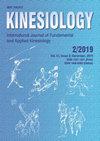STRENGTH VALUES OF SHOULDER INTERNAL AND EXTERNAL ROTATORS IN JUNIOR TENNIS PLAYERS
IF 0.9
4区 医学
Q4 REHABILITATION
引用次数: 4
Abstract
Character of modern tennis game in the last decade has become significantly more dynamic, fast andpowerful, which brings high strain to joint and muscular system. The aim of this research was to establishstrength level of external and internal shoulder rotators, and to compare the competitive tennis playersgroup of boys (TEN, n=10, aged 12-14 years) and boys who did not perform any sport activity at competitivelevel (CS, n=10, aged 12-14 years) as well as to assess lateral differences in both groups. Using isokineticdynamometry method (Humac Norm CSMI Stoughton, MA, USA), we tested strength level of external andinternal shoulder rotators (180°/s, 300°/s). The TEN and CS group are comparable from the aspects of age,body height and body weight. Comparison of isokinetic strength values in TEN and CS groups proved significantlyhigher strength level of external and internal rotators in both (dominant and non-dominant) extremitiesfor the TEN group. The lateral difference assessment proved the insignificant difference in externaland significant difference in internal rotators in the TEN group, and the insignificant difference in both theexternal and internal rotators in the CS group. A lower strength level was found in the internal rotators incomparison with the external rotators in both groups (for both the dominant and non-dominant extremity),whereas in the TEN group lower differences between the external and internal rotators of the dominantextremity were proved. Although researches on adult highly skilled tennis players refer to a higher strengthlevel of the upper extremity internal rotators, this fact has not been pronounced in the TEN group. An idealexternal/internal rotators ratio in adult players is considered within the interval of 66-75%. Significantlyhigher values obtained in the TEN group might be attributed to lower age and also lower performance level.It can be said that the level of isokinetic strength in the TEN the group is significantly higher than in the CSgroup, due to the influence of long-term game and training load. Key words: isokinetic dynamometry, glenohumeral joint, muscular dysbalances, prediction of injury青少年网球运动员肩部内外旋肌的力量值
近十年来,现代网球运动的动态、速度和力量明显增强,这给关节和肌肉系统带来了很大的压力。本研究的目的是建立外旋肩部和内旋肩部的力量水平,并比较竞技网球运动员组(TEN, n=10,年龄12-14岁)和没有进行任何竞技水平运动的男孩组(CS, n=10,年龄12-14岁),并评估两组的横向差异。采用等速动力学方法(Humac Norm CSMI Stoughton, MA, USA),我们测试了外旋肩和内旋肩(180°/s, 300°/s)的强度水平。TEN组和CS组在年龄、身高、体重等方面具有可比性。TEN组和CS组的等速强度值的比较证明,TEN组(优势和非优势)四肢的外旋体和内旋体强度水平明显更高。横向差异评估证明TEN组外旋体差异不显著,内旋体差异显著,CS组外旋体和内旋体差异均不显著。两组(优势肢和非优势肢)内旋体的强度水平均低于外旋体,而在TEN组中,优势肢的外旋体和内旋体之间的差异较低。尽管对成年高技能网球运动员的研究表明上肢内旋肌的强度水平更高,但这一事实在TEN组中并未得到明显的证实。成人球员理想的外旋/内旋比例在66-75%之间。TEN组获得的显著较高的值可能归因于较低的年龄和较低的表现水平。可以说,由于长期比赛和训练负荷的影响,TEN组的等速力量水平明显高于cs组。关键词:等速动力学,肩关节,肌肉失衡,损伤预测
本文章由计算机程序翻译,如有差异,请以英文原文为准。
求助全文
约1分钟内获得全文
求助全文
来源期刊

Kinesiology
REHABILITATION-SPORT SCIENCES
CiteScore
1.90
自引率
8.30%
发文量
16
审稿时长
>12 weeks
期刊介绍:
Kinesiology – International Journal of Fundamental and Applied Kinesiology (print ISSN 1331- 1441, online ISSN 1848-638X) publishes twice a year scientific papers and other written material from kinesiology (a scientific discipline which investigates art and science of human movement; in the meaning and scope close to the idiom “sport sciences”) and other adjacent human sciences focused on sport and exercise, primarily from anthropology (biological and cultural alike), medicine, sociology, psychology, natural sciences and mathematics applied to sport in its broadest sense, history, and others. Contributions of high scientific interest, including also results of theoretical analyses and their practical application in physical education, sport, physical recreation and kinesitherapy, are accepted for publication. The following sections define the scope of the journal: Sport and sports activities, Physical education, Recreation/leisure, Kinesiological anthropology, Training methods, Biology of sport and exercise, Sports medicine and physiology of sport, Biomechanics, History of sport and Book reviews with news.
 求助内容:
求助内容: 应助结果提醒方式:
应助结果提醒方式:


